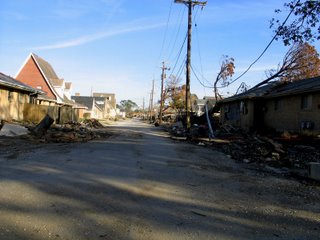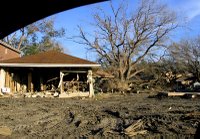
The image that you see to your right is perhaps on of the best reminders of just were we are today. It was not taken in some bombed-out community on a foreign land. No, that is a street in the Lakeview district of New Orleans. And the images is not dated in months--but in weeks. Yes, it still looks this way. Perhaps the folks in the coastal enclaves of this state should sit back and, when they see such a haunting image, remember that they were not alone. Even well-heeled and affluent areas of the state were among the victims in 2005, and like so many others they remain that state of despair even now.
And that is what has sickened me enough to draft this entry.
On Wednesday afternoon, I joined about 200 or so people at the Houma civic center to hear a presentation by the Coastal Protection and Restoration Authority of Louisiana, and while there, I was blown away by something that I never thought that I would witness: the framing of an "us" versus "them" argument, as it comes the protection of our vulnerable Louisiana coastal.
The presentators, CPRA, are an assemblage of state-sanctioned leaders and experts tasked with the mission of devising a system to protect our region from future versions of Katrina or Rita--or worse. After months of studies, public workshops, meetings, and the like, what they showed the audience in Houma, as well as audiences in Lake Charles and in New Orleans, was, to date, the state's boldest and most comprehensive plan of fortification. Granted, it was not news to me; I had seen this mapped out in a book by Ivor van Heerden, a researcher with LSU. His plan was a elaborate super-structure that called for the creation of a Cat-5 levee system that would snake the state along the Intracoastal waterway, a series of sediment diversion channels, and awe-inspiring floodgates at some our most vulnerable inlets.
The plan for this Cat-5 protection system, as presented by the CPRA, did have some variations, though. Specifically, the levee system still would protect the larger urban areas along the coast--New Orleans, Houma-Thibodaux, Lake Charles, and Abbeville-Lafayette. And beyond that, the CPRA also advocated the creation and maintenance of several less-than-Cat-5 levee systems to protect the areas outside of the super fortification. Indeed, places like all of Intracoastal City and Cameron, as well as points below the Houma airport and even Plaquemines (below Belle Chasse)and St. Bernard (south and east of Poydras) parishes will not be inside the Cat-5 levee. And so, because there are thousands along the fragile coast who will need some type of protection, these less -than-superior levee configurations will be the best and most feasible that the state will offer.
But, to some people, this was not enough...
At the Wednesday meeting in Houma, residents from the lower environs of Lafourche and Terrebonne cried out in anger. One even went as far as to say, "If you ain't gonna protect [us], you better not protect New Orleans!" Those words led the room to erupt in applause and cheers. ("What the hell!" I thought to myself.) While defiance is not anything new for people in that part of the swamp, the attitude seemed a bit extreme. Unfortunately, their sentiment of frustration was echoed in New Orleans and in Lake Charles. The people of our state's coastal environs, from lower Plaquemines to Holly Beach, were appalled by the idea that the state was going to leave them "unprotected". Coastal residents everywhere were demanding that the state move the concept for a Cat-5 fortification farther south.

To the credit of the panel, though, every effort was made to devise a plan capable offering some real risk mitigation techniques. Their plan does not just call for levees. They also want to divert river water and sediment back into the marshland, close the MRGO, rehabilitate the barrier islands, and so on. All of these things, along with the fortification, will take an estimated twenty years to complete, and the price tag for this entire effort is so large that, well, it is unknown.
That is where I'd like to begin an assessment: how much will this cost? During the presentation, the spokesman for the CPRA suggested that a federal and state partnership was necessary to get this endeavor underway. And one citizen at the Houma meeting basically said that we should believe "the cost for protecting [his] way of life", like the cost of national security, was irrelevant. Unfortunately, that is not going to happen, sir; it is very relevant. There are 49 other states in this union, and many of their residents are largely unmoved by our continuing plight here in South Louisiana. And for that matter, even our own brethen in the Feliciana North don't think much of our coast situation, and they have been largely indifferent, and at times outri
 ght hostile, in the legislature, when it comes to commitments for our needs. That said, the price tag will matter a great deal to so many outside of this region.
ght hostile, in the legislature, when it comes to commitments for our needs. That said, the price tag will matter a great deal to so many outside of this region.Of course, a Cat-5 levee fortification would have a profound impact on life in South Louisiana. For starters, once completed and certified, it would lead to the easing of some elevation requirements, hence lowering construction costs on both commercial and residential properties. It could also lead to a reduction in some insurance rates, though not all. And perhaps we could spur economic redevelopment in so many areas, as people become more confident in their new infrastructure. Consequently, it is important for so many reason that our state does embark on this path.
But having said that, we have to make some concessions. Granted, it is not fair to tell any person that their way of life is without salvation, or that their homes must go without protection, but we must be truthful with ourselves. The 2005 hurricane season dealt us a painful blow, and now our reality is different. To some, Louisiana is on the vulnerable frontlines of the global climate fight, and to insurers and investors, it is unwise to place bets here. That is, until we accept our new reality, and make the changes necessary to mitigate risks. Those changes are expensive, but if done efficiently and properly, we have a real shot at saving something.
And that is it. We can save something...While there is no real way to save everything, simply because few will tolerate the inordinate expense, we have been offered a plan that does save something. In this case, we will act to protect our most vulnerable urban areas along the coast. That will take twenty years, but at least it is a start. And for that reason, I actually applaud the efforts of the CPRA.
This entry, undoutedly, might have served to offend a few of my friends and associates who have interests in places like Chauvin or Venice or Delacroix or Vermillion. They will call me uncaring or shallow, or they will ask, "How can you endorse something that will leave so many without protection?" And to them, I say this: I am deeply sorry for your plight, and I pray to God that we can find a way to help you. It is unfortunate that any of us faces this challenge, but your situation and my own notwithstanding, there is a great need to be objective and concise now
 . There is a need to accept reality as it is, however unpalatable, then adapt and cooperate to meet its new callings. In order to protect any facet of South Louisiana, I know that our new reality dictates that some sacrifices will have to be made. A retreat inland, though not popular, is perhaps the best option we have now. The cost of doing so may be more tolerable to those who will be asked to help us. And if you do not agree, then you should consider that the cost of doing nothing will only leave us susceptible to prospects of further agony in the time to come.
. There is a need to accept reality as it is, however unpalatable, then adapt and cooperate to meet its new callings. In order to protect any facet of South Louisiana, I know that our new reality dictates that some sacrifices will have to be made. A retreat inland, though not popular, is perhaps the best option we have now. The cost of doing so may be more tolerable to those who will be asked to help us. And if you do not agree, then you should consider that the cost of doing nothing will only leave us susceptible to prospects of further agony in the time to come.The CPRA did not present a perfect plan, but they should be commended for presenting a plan, period. At least now we can go forward--and the sooner we do so, the better. After all, this will take two decades to implement, and only God knows what awaits us in the interim.
Remember, we are in this together, and should we not act now, then we will surely be in the same boat, crying together.
gh
Matt 5:16




No comments:
Post a Comment